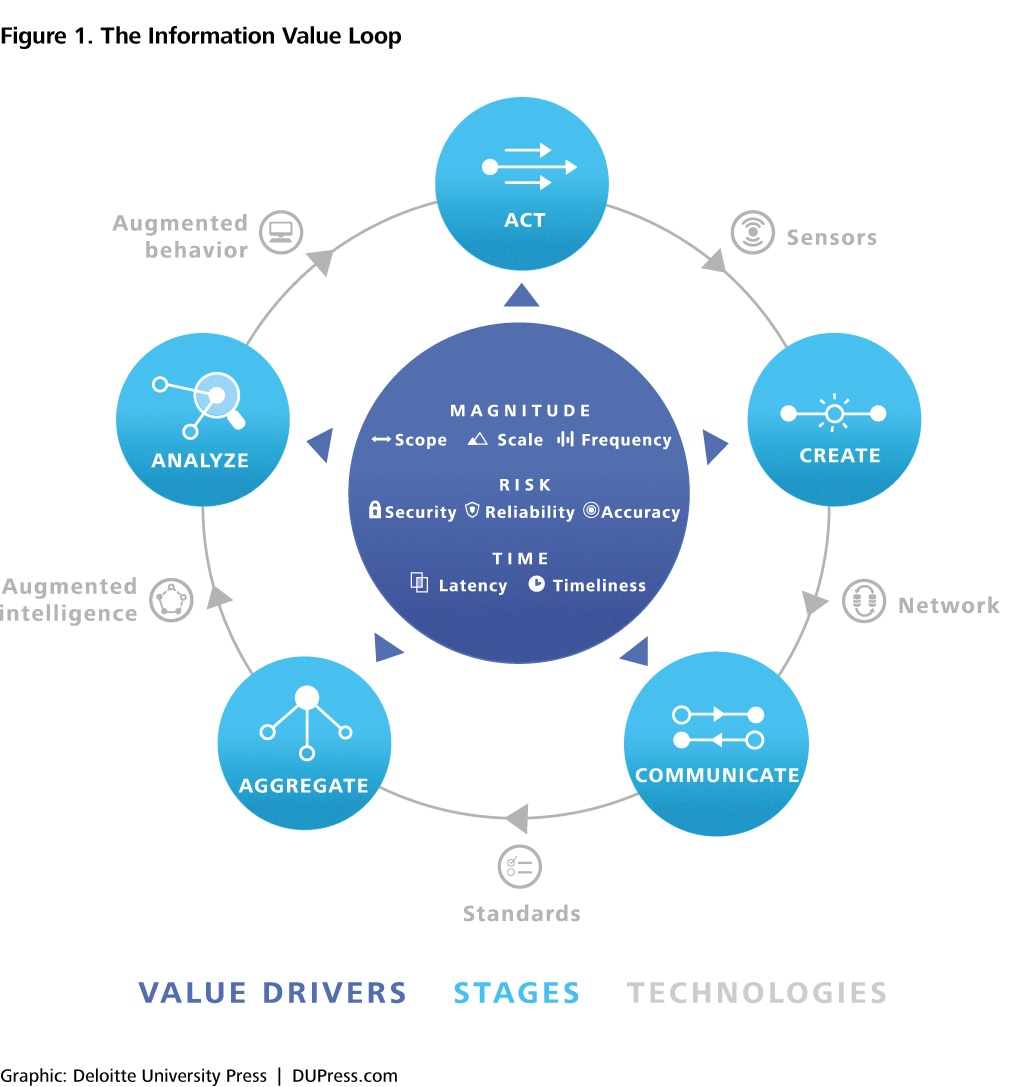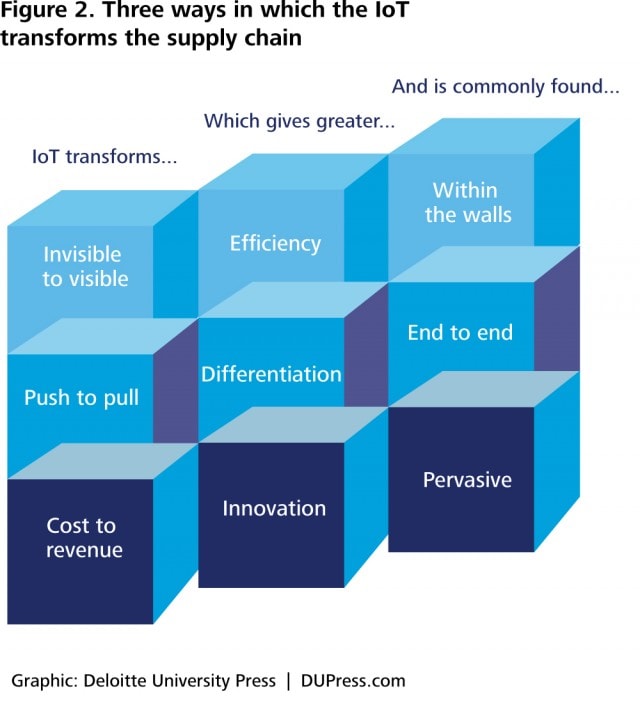Forging links into loops: The Internet of Things’ potential to recast supply chain management has been saved

Forging links into loops: The Internet of Things’ potential to recast supply chain management Deloitte Review Issue 17
28 July 2015
Faced with external pressures, US companies often cut costs to remain competitive. True to form, many have focused their Internet of Things strategies on how the technology can cut costs and improve efficiency. But the IoT can also serve as a foundation for greater differentiation and innovation.
Subscribe to receive IoT insights
Explore the Internet of Things collection
Contrary to the image of swashbuckling Silicon Valley start-ups, research has shown the majority of US companies to be rather conservative. When faced with external pressures and challenges, they most often react by cutting costs to remain competitive.1
The  Internet of Things (IoT) is among the preeminent challenges of the 2010s. A technically complex concept, the IoT brings regulatory, process, and relationship challenges to every aspect of a business. And, above all, as an emergent technology with competing standards and platforms, the IoT is still a risky investment to many companies. True to form, many companies have focused their IoT strategy on how the technology can cut costs and improve efficiency. A simple Internet search for “IoT” and “supply chain” yields numerous articles about how the IoT can help a company do things faster or with fewer personnel. And, yes, the IoT can certainly do these things. But it can also be a transformative force in a supply chain, opening new possibilities not only for improved efficiency but for greater differentiation and innovation as well.
Internet of Things (IoT) is among the preeminent challenges of the 2010s. A technically complex concept, the IoT brings regulatory, process, and relationship challenges to every aspect of a business. And, above all, as an emergent technology with competing standards and platforms, the IoT is still a risky investment to many companies. True to form, many companies have focused their IoT strategy on how the technology can cut costs and improve efficiency. A simple Internet search for “IoT” and “supply chain” yields numerous articles about how the IoT can help a company do things faster or with fewer personnel. And, yes, the IoT can certainly do these things. But it can also be a transformative force in a supply chain, opening new possibilities not only for improved efficiency but for greater differentiation and innovation as well.
Deloitte Review, issue 17
See the full issue
Join the conversation
#DeloitteReview
The chain meets the loop
From the term’s first use in 1982, the very words “supply chain” have implied a linear process.2 Even as supply chains have in reality become complex networks, the basic steps—receive materials and components from upstream, create products, and distribute those products to customers downstream—leave us with the largely accurate image of links in a chain. The value a company creates with its supply chain has traditionally been determined largely by how well it manages those links and the connections among them: The better the product, the faster its production, and the cheaper its cost, the better the supply chain is functioning.
Enter the Internet of Things. This suite of technologies—sensors, communication devices, servers, analytics engines, and decision-making aids—has the ability to link the physical and information worlds more closely than ever before. Using a closed loop based on bits, it creates fundamentally new, non-linear ways to manage what has traditionally been a linear sequence of steps, expanding options for managers looking to create value.
By collecting data from real-world objects, communicating and aggregating those data into information, and then presenting information to users so that decisions can be made to make, move, or change real objects in the world, the IoT reconnects information and things. Even the simple fitness monitor on your wrist collects information about an object in the physical world—in this case, you—then communicates, aggregates, and analyzes that information before presenting back to you a prompt that can help your decision making: “You have not met your activity goal for the day.”
Thanks to the IoT, information that a product generates is becoming a critical component of that product’s value, and the information continues to be created and communicated after delivery (see “The more things change”). The supply chain ends when a product has been delivered to a customer, but the flow of data persists, continuing to create value.
Information’s “value loop” consists of stages, each enabled by specific technologies (figure 1). An act is monitored by a sensor that creates information; that information passes through a network so that it can be communicated; and standards—be they technical, legal, regulatory, or social—allow that information to be aggregated across time and space. An enterprise uses augmented intelligence, or analytical support, to analyze the information, and the loop is completed via augmented behavior technologies that either enable automated autonomous action or shape human decisions in a manner leading to improved action.

Just as “better, faster, cheaper” are the value drivers of traditional supply chain management, their analogs—magnitude, time, and risk—determine the value of the information content within a supply chain. More information (scale) is valuable to supply chain managers because it allows them to know about more specific objects and make more informed decisions. Knowing more about more objects involved in a process (scope) and refreshing that information more often (frequency) also increases value. Similarly, faster information is not just the speed at which it moves down cables or over a wireless signal; it is also whether the information arrives in time so that a manager can make a decision (timeliness) and how long it has been since measurement (latency). Finally, all the information in the world does no good, and can actually do harm, if it is wrong (accuracy), garbled (reliability), or stolen or corrupted (security).
In short, modern supply chain management can be not only about getting products faster, cheaper, and of better quality but also about getting managers the right information at the right time, so that they can better make informed supply chain decisions.
Creating value from information in these ways can have potentially profound implications. Traditionally, a central objective of supply chain management has been to minimize variation in the supply chain. Variation has long been the enemy of efficiency because when variation in upstream links was revealed, it was typically too late for downstream links to respond—a concept referred to as the “bullwhip effect.” Now, however, the information provided by IoT deployments allows supply chains to invest less in eliminating variation because timely and effective responses are now possible, and instead to use variation as a foundation for new types of competitive advantage and even as a driver of innovation (figure 2).
Efficiency: From invisible to visible
Advanced technology is not new to supply chains: Robotics, machine to machine, and other connected systems have reduced waste and improved supply chain efficiency for decades. However, even with these high-tech aids, if you were to ask any supply chain manager about the location of an item within that chain at any point in time, or about the status of a piece of processing equipment, he or she would be hard-pressed to tell you. That is not necessarily a failing: In the traditional context of supply chain management, that level of information was, unavoidably, relatively uncommon. As a result, management processes emerged to limit variation and so improve efficiency without on-demand knowledge of every item’s location.
IoT solutions can make supply chains less dependent on smooth, even flows. By making the invisible visible, supply chain managers are increasingly able not only to minimize variation but also to respond to it. An example is General Motors’ monitoring system. The company has deployed a standardized, Internet Protocol-based communication system, the Plant Floor Controls Network, across many of its manufacturing facilities, allowing it to integrate a variety of operational and enterprise processes. By positioning a network of sensors throughout its plants, GM is able to measure humidity in the buildings. If readings rise above those acceptable for painting vehicle bodies, then the next body on the line will automatically be routed to a different portion of the manufacturing process that is not adversely affected.3 This process change reduces both repainting and downtime on the line. Cisco, the software provider, calculates that the reductions in repainting alone have saved GM millions, and the whole program is slated to realize a 166 percent return on investment (ROI) within five years.4
Another example, from Whirlpool, highlights how the IoT can be used not only in routing work but in locating misplaced inventory. Until as recently as 2012, the world’s largest washing machine factory, in Clyde, Ohio, used manual processes to read paper tags and manage inventory as washing machine lids flowed from initial stamping into finished, painted products for final assembly. The process was cost-intensive and error-prone, with multiple manual reads of the tag as each lid moved from stamping to final assembly. Despite having more than 2.4 million square feet of factory space, there was no room available for excess inventory when tags fell off or were misplaced or misread. Plant managers continually changed production schedules based on lost parts, leading to higher inventory and less space.
Instead of using bar codes or a similar solution, Whirlpool opted to deploy radio frequency identification (RFID) tags and networked readers across the plant to give managers and operators real-time access to information on the flow of materials. Based on a system by developer Omni-ID, lift drivers and paint-line employees are now able to make decisions on the fly and immediately know if they’ve loaded the correct parts on the assembly line. The result is that inventory is down, quality is up, and Whirlpool is now using RFID to schedule inbound logistics to the paint line and introduce a true “pull” production system. The system exceeded expected ROI based on the reduction in the cost of paper tags alone.5
Both of these examples played out entirely “within the walls” of each organization involved. General Motors and Whirlpool were each deploying IoT technologies to links in their supply chains over which they effectively exercised total control. Each deployment created an information value loop that transformed the invisible to the visible, allowing each company to realize valuable efficiencies.
Differentiation: From push to pull
When pursuing these sorts of “within-the-walls” IoT deployments, there are typically few challenges associated with capturing the value being created. But with these advantages come limits: Very often, it can be difficult to do more than increase the efficiency of existing processes. To realize still greater value from the IoT, it is frequently necessary to deploy IoT-enabled capabilities across a greater length of the supply chain and include either or both upstream and downstream segments—and, at those limits, to go “end to end.”
When considering elements of a supply chain beyond a company’s direct control, managers have to consider other companies’ systems and processes. Components need to be moved across distances, which opens up the possibility of everything from loss to damage (see “Safeguarding the Internet of Things”). Even the weather can be a factor. As a result, supply chain coordination is a classic consideration of supply chain management. In the same manner that IoT applications within the plant increased the visibility of parts and processes, using the technology across the supply chain can improve productivity, reduce costs, and enhance the customer experience (see “The IoT’s about us”).
The Whirlpool example illustrates how the visibility of supply chain operations gained within a company’s four walls can create greater value through greater scope. As with any organization facing broad product manufacturing across a small network, Whirlpool has as lean a supply chain as possible but faces complex supplier, inventory, and materials management issues—both internally and externally—to produce washers at its flagship Clyde plant.6
We described above how Whirlpool implemented an RFID system for materials management to handle inbound material for a single process—painting—to help identify incoming washer lids and locate them spatially within the plant. This simple, low-cost, limited data tag became the internal, electronic kanban for consumption triggers throughout the plant. Within 18 months, the company had connected the RFID system to supplier ordering systems and began using it as an order-management technique to schedule inbound shipments and drive upstream orders. Now, when stocks of components or raw materials run low, the system can automatically reorder them to keep production running at full speed.7
The potential benefit of this type of IoT application goes beyond moving washing machine lids through the plant more quickly to affect the entire supply chain. These end-to-end IoT applications build upon applications within the plant, touching suppliers and distributors by automatically controlling orders. This generates opportunities for valuable competitive differentiation.
For example, in the face of rising fuel prices through the 2000s and early 2010s, supply chain managers sought to reduce transportation costs by combining trucking delivery routes. Unfortunately, this creates a painful trade-off: Combining routes in the interest of cost cutting can reduce a company’s ability to meet the needs of the increasing number of customers who demand products and services customized to their individual needs.
Using IoT-enabled capabilities to create a value loop that stretches across the affected links of the supply chain alleviates this tension. Sensors give managers a clearer view of products moving through a supply chain—and similar visibility into customers’ habits. A company selling multiple varieties of toothpaste, for example, can determine in real time where and when whitening is outselling tartar control, allowing managers to more accurately segment their customer population. The rapid feedback allows companies to act on that knowledge, directing the right type of toothpaste to the right customers.
Not only does this increase the company’s recognition and brand compared with competitors’, it offers demonstrably better results than do undifferentiated supply chains. One study found companies with supply chains segmented by customer delivered goods faster for a third less than those that did not segment.8
By allowing for the adoption of knowledge-as-a-service models, the IoT is creating new value in supply chains. But with a whole ecosystem competing for that value, the spoils will likely be split between companies, suppliers, customers, and even third-party carriers.
Innovation: From cost to revenue
The IoT allows companies to shift their supply chain management priorities from suppressing variation to exploiting it. In its fullest expression, this allows a company to transform its supply chain from a cost center into a revenue generator. Doing so, however, can require that companies go beyond their own four walls, beyond even the extent of the supply chain, and integrate their customers and supply chain into a full-fledged ecosystem.
If IoT applications allow companies to stock only the inventory they need when they need it, companies can go further still and do the same for customers, integrating them into the supply chain—since, unsurprisingly, customers are willing to spend money to get what they need when they need it. Pervasive IoT applications that stretch across the product ecosystem will collect valuable customer information, and innovative business models can then emerge, turning information from the supply chain into a service that companies can sell, creating new value and generating additional revenue.
For example, a leading logistics and delivery company shows how IoT-based supply chain information can quickly grow into a new offering. For years, the company has tracked packages to make its delivery system more efficient; in fact, customers often rely on the tracking information, knowing exactly when and where a package has been delivered. It stands to reason that corporate customers with sensitive supply chain needs might value even more detailed information—and the ability to act on that information. In 2009, the company introduced a set of configurable sensors that can monitor a range of factors: location, temperature, humidity, barometric pressure, and even light exposure. Data from these sensors are collected live and aggregated on central servers, where analytics send push alerts to customers if preset criteria are met.9 For the customers shipping packages, the knowledge that a shipment of frozen food has begun to thaw allows them to take action and order a refreezing, saving the shipment and revenue lost to spoilage or other damage. For the logistics company, this has opened another avenue to generating revenue beyond simply moving packages across the country.
This type of knowledge-as-a-service model appears to be catching on. According to a survey of business leaders, 74 percent of those who implemented initiatives such as sensor-based logistics saw increases in revenue. In fact, the average supply chain contribution to a company’s bottom line increased from 4 percent to 8.5 percent in only one year, with industry leaders seeing supply chain revenue contributions on the order of 10 percent.10
By allowing for the adoption of knowledge-as-a-service models, the IoT is creating new value in supply chains. But with a whole ecosystem competing for that value, the spoils will likely be split among companies, suppliers, customers, and even third-party carriers; the IoT’s real-time nature can help companies capture more of that newly created value for themselves.
A large European cargo rail consortium, Deutsche Bahn AG, has demonstrated one way in which companies can capture some of the new IoT-generated value. Indeed, rail operators can be considered one of the originators of the IoT: For several generations, they have used in-field sensors to monitor signal status and track information. Deutsche Bahn took these traditional systems a step further and installed a network-wide monitoring system to manage and plan its entire rail network.11
That system comprises over 1 billion supply chain “nodes”—collecting data on each segment of track, rail car, station, engine, switch, and signal—that span the global operating network, and it monitors the condition of all of these things in real time. These data flow back to a control tower that aggregates them every five seconds to provide near-real-time information across the entire fleet. Deutsche Bahn took the approach of integrating these signals from a disparate set of information across standard IPv6 protocols into a fast, operational database management system capable of processing this information in near real time. The system could then push such information, once integrated and aggregated, to a variety of end users and a range of communication channels, from traditional enterprise resource planning to central regionalized planning centers, individual locomotives, or even a consumer’s smartphone.12
Deutsche Bahn has used these data to improve risk management practices. For instance, if a node is congested or dark, which means that a signal is out or a section of track is not functioning, the system can provide real-time rerouting and optimization in light of all existing network traffic through nodes.
At that level, the IoT works much like Whirlpool’s RFID system does, efficiently moving 1,000-ton trains in place of five-pound washing machine lids. However, Deutsche Bahn also integrated the monitoring system with planned customer orders and billing information; this aggregation of diverse sets of data enabled the company to create dynamic cost-to-serve pricing models. In contrast to traditional cost-plus pricing, Deutsche Bahn was able to examine traffic patterns, network usage, freight type, destination, and a customer’s desired timetable to generate a price specific to a customer’s needs. This allowed Deutsche Bahn to better determine customer needs and the cost of fulfilling those needs. In doing so, the company is able to capture a larger portion of the value generated by moving passengers and freight.13
When operating at the ecosystem level, the demands placed on an IoT application are immense, with large volumes of data created and transmitted throughout the system. However, the real challenge comes when those data reach the “analyze” step of the value loop. If companies aim to set individualized prices as Deutsche Bahn does, then they are committing to crunching an IoT application’s mountains of data through algorithms in near real time. This requires complex analytics tools and massive computational power. Analytics engines such as the open source software R are beginning to provide less-expensive options, but specialized investment may still be required to get the information flowing smoothly.14
Steps and missteps
The interactions, technologies, and processes within a supply chain can be difficult to navigate. Traditional supply chain management techniques focused on one path through that forest, relying on controls to minimize variation. However, with some level of variation being inevitable, managers need the ability to react to uncontrollable variation. The IoT offers the ability to see and react to that variation, effectively opening up new paths to supply chain management.
- Efficiency: The IoT’s ability to make visible previously unseen information about a supply chain allows for greater efficiency than process controls alone. IoT solutions with this goal are typically found “within the walls,” making a particular plant or facility run more efficiently.
- Differentiation: By expanding within-the-walls IoT applications to include suppliers and distributors in an end-to-end supply chain, companies can transform push-driven order systems to pull-driven ones. These applications can have the same efficiency gains as within-the-walls applications, but they can also improve customer experience, providing for greater differentiation.
- Innovation: Pervasive IoT applications that integrate customers and the end-to-end supply chain into a single product ecosystem open the possibility of new, innovative business models. Among the most interesting of these new business models are those that transform the supply chain from a cost burden to one that can generate revenue itself.
There is no magic bullet or single answer for IoT applications. However, the transformations that the IoT can bring do open up the possibility for new improvements and allow companies to find new paths to supply chain management.
© 2021. See Terms of Use for more information.





